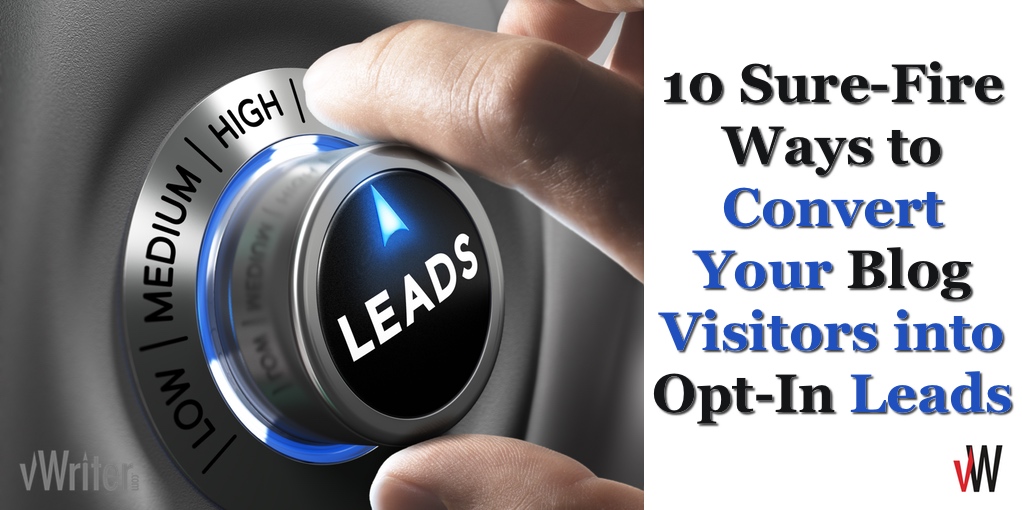Get this wrong, and you’ll struggle to make blogging work.
But by converting as many visitors as possible into opt-in leads, you can:
- Build trust and credibility through more content and continual follow-up.
- Encourage them back to your site repeatedly, further building the relationship.
- Convert them over time into customers for your business (presuming you’re monetizing your blog properly).
Look at your blog and make sure there are conversion points that will in essence turn every post into a landing page.
SocialMediaExaminer
The good news is there are lots of different approaches you can use to capture the email address of your visitors and convert them into opt-in subscribers. They’re relatively easy to implement too, thanks to the various powerful plugins available.
The trick is to find the right mix for your blog that maximizes your opt-in conversion rate.
This post runs through the top ten most effective opt-in approaches for blogs, and shows you how to put them into action today.
Using the right approach can often double if not triple your existing opt-in conversion rate.
Use an Effective Lead Magnet
Regardless of the exact mechanism(s) you use to convert your visitors into leads, to be effective the visitor must feel it’s in their interest to give you their email address.
It’s a value exchange.
What can you offer that means the visitor will willingly enter in their email to receive it?
Test different lead magnets over time to find out what works best for your market.
Ready to get started?
Here are 10 sure-fire ways to convert visitors to your blog into opt-in leads you can then build relationships with and sell products and services to over time.
 Content Upgrade
Content Upgrade
A content upgrade is a type of highly-targeted lead magnet, specifically related to the content the visitor is looking at.
So for a typical blog post, a reader might be able to download a PDF version of it in return for an email address. Other options might include a related report, checklist or video training.
Content upgrades are usually offered via inline links within the main content itself, or via some additional text. There’s an example above, and here’s another example from a previous post on this blog:

The link can lead to a suitable squeeze page, or display a popup with a relevant opt-in form. LeadPages, OptinMonster, SumoMe and optinopoli all provide popups you can use for this purpose. The latter gives you options specifically designed for content upgrades and is the software used on this blog.
 Floating Header Bar
Floating Header Bar
A floating header bar stays in place as you scroll down the page. It’s used to display an opt-in offer continuously to the visitor in an unobtrusive, but noticeable, fashion.

A popular option is Neil Patel‘s HelloBar, an example of which is shown above from Heidi Cohen‘s blog.
OptinMonster also provide a Floating Bar option, available for both top and bottom.
Again, optinopoli has a version referred to as a ‘Smartbar’, and can also be used to e.g. show a popup when a button is clicked.
 Timed or Scroll Popup
Timed or Scroll Popup
Scroll popups appear as the visitor scrolls past a certain point down the page, or they’ve been on the page a certain amount of time.
They’re designed to be unobtrusive and to allow the visitor to engage with the content before showing the opt-in offer. As with other similar opt-in mechanisms, depending on the plugin used, you can usually set it to appear only once to a visitor within a specified timeframe.
Here’s an example of a timed popup, as used on Chris Brogan‘s blog – this one is currently timed to appear after 25 seconds.

Options for WordPress include:
- OptinMonster for timed popups (their scroll option is for a corner popup, see #10 below)
- SumoMe for what they call a Scroll Box.
- Dreamgrow is another popular choice for a scroll popup.
optinopoli can be used on WordPress as well as other platforms, and gives you timed and scroll options for their popups.
 Exit Intent Popup
Exit Intent Popup
These popups appear when the visitor’s mouse moves in a way that indicates they’re about to leave the site.
By showing just before the visitor is (apparently) about to leave, they are probably the least disruptive option for the visitor, while enabling you to invite them to subscribe to your list.
There’s an example on Yaro Starak‘s blog Entrepreneur’s Journey that uses the OptinMonster plugin:

Other WordPress options include Optimonk, BrightInfo and optinopoli. Again, the latter can be used on sites other than WordPress too.
 Welcome Full Screen Offer
Welcome Full Screen Offer
You’ve no doubt seen this type of opt-in mechanisms on blogs around the web, with a full screen opt-in offer displayed that you have to dismiss before seeing the content of the blog itself.
It’s probably the most intrusive option for the visitor experience, but also one of the most effective. Settings usually allow you to ensure it only shows to the visitor once within a certain time frame.
Here’s an example on Jeff Goins‘ blog, using SumoMe’s Welcome Mat option:

Other options include:
- OptinMonster’s Welcome Gate
- optinopoli‘s Welcome Mats.
 Floating Footer Bar
Floating Footer Bar
Similar to the floating header bar described in #2 above, as you’d expect the floating footer bar rises from the bottom, usually as you scroll down the page or after a certain number of seconds.
Typically, they will show a short message and a button for you to click leading to an opt-in squeeze page (or anywhere else you choose).
This is an example when using the WPFront Notification Bar plugin:
![]()
This plugin also works with floating header bars.
Other options for a floating footer bar, as with #2 above, is to use OptinMonster and their Floating Bar function, or optinopoli‘s Smartbars.
 Sidebar Ad
Sidebar Ad
A simple option is to simply show an ad for your list in the sidebar of your site.
This could link to a squeeze page – here’s an example from copyblogger.com:

Alternatively, and likely to drive higher conversions, it might show the opt-in fields directly. Here’s an example from Jeff Bullas‘ blog:

OptinMonster lets you create sidebar forms for your blog, as does optinopoli with their Widget option.
You’ll boost conversions further if the ad scrolls down the page with the visitor rather than remaining static at the top. One way to implement this is via the free Q2W3 Fixed Widget (Sticky Widget) plugin, which has high ratings, tens of thousands of downloads and appears to be regularly updated.
 End of Post Opt-In Offer
End of Post Opt-In Offer
At the end of your posts you can also put a banner or link that directs to a landing page, or an opt-in form directly.
Here’s an example of an opt-in form used on QuickSprout.com:

Of course, it can be a lot simpler than this, such as the opt-in sidebar ad in #7 above.
One way to achieve this is through the Bottom of every post plugin. It allows you to add text or code that appears, as you might expect, at the bottom of every post.
While the plugin has not been updated in quite a while, it’s such a simple plugin under the hood that it probably doesn’t need to be and reportedly still works fine.
Probably easier though is to use optinopoli‘s Widget feature, which gives you the option of showing an inline form, or having say a link or a button linking to a lead page.
 Header Menu Link
Header Menu Link
While people might ignore clicking on a banner due to banner-blindness, they are used to clicking on navigation links.
Take advantage by adding a simple link or button to your navigation menu leading to a page where they’ll need to enter their email.
Depending on your niche, this could for example offer a free trial or demo for some software, a free appointment or consultation, entry to a forum, as well as more traditional lead magnets.
For example, on Unbounce’s blog, they have a simple Sign Up button leading to a free trial offer: no credit card required, just your name and email.

In other words, their lead magnet is 30 days’ usage of their system for free. It’s part of a mix of opt-in offers they use.
Or on Ana Hoffman‘s TrafficGenerationCafe, she uses a basic link in her menu to an opt-in page:

 Corner Popup
Corner Popup
A corner popup is more subtle and less intrusive, but still attracts attention from visitors. It usually displays as the visitor scrolls down the page.
Here’s an example of one in action from Michael Stelzner‘s SocialMediaExaminer.com using OptinMonster’s Slide-in Scroll Box:

You can do the same with the free optinopoli software.
![]()
Advanced Strategies
Got your opt-in strategy in place? Want to go up a level?
Here are a couple of advanced strategies to drive your lead conversion rate higher.
Retargeting
Retargeting is where ads are shown to visitors who have since left your site.
You can use it to encourage visitors to opt-in if they left without doing so.
It’s most effective where the lead magnet referred to in the retargeting ad is closely related to the content they consumed on your site. This makes it highly targeted, and therefore likely to drive a higher response.
Common retargeting networks include Facebook and Google Adwords.

Select Google’s Display Network to start an opt-in retargeting campaign within Adwords
A/B Split Testing
Continually test different approaches on your blog to find out what works best for you. Even small changes to a button can make a radical difference to your opt-in rate.
Such testing is immensely valuable for any business, and should be an obsession for any marketer.
Here’s a quick, simplified example of just why testing is so valuable.
Let’s say the opt-in rate on your blog is 5% on average, and you convert 5% of those into customers over time.
So for every 1000 visitors:
- You get 50 opting in.
- You get 2.5 customers.
You do some simple testing, say a new lead magnet or different opt-in mechanism. After a couple of tests, you’ve doubled your opt-in rate to 10%.
In so doing, you’ve not just doubled the number subscribing to your list. You’ve also doubled your future sales.
But you’re also testing your sales process. After making a few changes, you start converting 10% of your list into customers over time.
So, you’ve now:
- Doubled the number of leads.
- Doubled the sales those leads result in.
Let’s see what that now means for the numbers.
For every 1000 visitors:
- You get 100 opting in, double what it was before.
- 10% of these convert, giving you 10 customers, not the 2.5 it was before.
In other words, you now have a 400% sales lift from some simple testing on both your opt-in and sales processes.
Because each visitor is now worth so much more to you (4x as much!), you are now free to invest more in acquiring those visitors, and your business can scale more easily.
So How Do You Test Opt-In Mechanisms on Your Blog?
The good news is that OptinMonster, SumoMe and optinopoli, the top lead generation options mentioned in this post, provide you with A/B split testing facilities:
- OptinMonster’s A/B split testing
- SumoMe A/B testing guide
- optinopoli’s guide to setting up your first split test
![]()
To Conclude
Your blog, as well as content repurposed and published elsewhere, can be seen as a large casting net, aiming to attract your marketplace and capture the details of as many visitors as possible.
An effective opt-in strategy for your blog allows you to do just that, with significant implications for your mailing list and of course your business and profit levels.
Maximizing your opt-in conversion rate makes content production and publication increasingly worthwhile, allowing you to invest more into it and see your online authority, influence and visibility continually increase.
In other words, it’s not something to put onto the back burner, but has immediate benefits for your business. Pick a mixture of strategies outlined above, add them to your blog, and for maximum results work on continually optimizing your approach.
Which of the above are you currently using? Which would you love to try? Or what mix do you see working for your site?
Share your intentions and/or your experiences in the comments below, and post a link so others can see your strategy in action.
(P.S. Remember to get the guide for converting blog traffic into leads).




